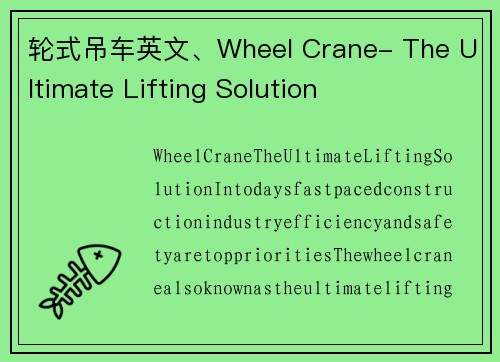Wheel Crane- The Ultimate Lifting Solution
In today's fast-paced construction industry, efficiency and safety are top priorities. The wheel crane, also known as the ultimate lifting solution, has become an indispensable tool for lifting heavy loads and materials on construction sites. This article will delve into the various aspects of the wheel crane, exploring its design, functionality, advantages, applications, maintenance, and safety features.
Design
The wheel crane is a versatile piece of equipment that consists of a rotating boom mounted on a wheeled chassis. The boom can be extended and retracted to reach different heights and distances, making it ideal for lifting heavy objects in hard-to-reach areas. The chassis is equipped with sturdy wheels that allow the crane to move easily across rough terrain and navigate tight spaces. Additionally, the crane is powered by a hydraulic system that provides the necessary force to lift and lower loads with precision.
The design of the wheel crane is carefully engineered to ensure stability and safety during lifting operations. The counterweights located at the rear of the crane help balance the load and prevent tipping. The cabin where the operator sits is equipped with advanced controls and safety features to ensure smooth and efficient operation.
Functionality
The wheel crane is designed to perform a wide range of lifting tasks, from moving heavy construction materials to assembling structural components. Its versatility makes it a valuable asset on construction sites, where space and time are often limited. The crane's ability to rotate 360 degrees allows it to reach multiple points without repositioning, saving time and labor costs.
The boom of the wheel crane can be fitted with various attachments, such as hooks, slings, and buckets, to accommodate different types of loads. The crane's hydraulic system provides precise control over lifting operations, allowing the operator to adjust the height, angle, and speed of the boom with ease. This level of control ensures that the crane can lift and place objects with accuracy and efficiency.
平博·pinnacle官方网站Advantages
One of the main advantages of the wheel crane is its mobility. Unlike traditional cranes that are fixed in one location, the wheel crane can be easily moved around the construction site to where it is needed most. This flexibility allows for faster and more efficient lifting operations, reducing downtime and increasing productivity.
Another advantage of the wheel crane is its compact size. Despite its powerful lifting capabilities, the crane has a relatively small footprint, making it suitable for use in tight spaces and urban environments. This compact design also allows the crane to be transported to different job sites quickly and easily.
The wheel crane is also known for its durability and reliability. Constructed from high-quality materials and components, the crane is designed to withstand the rigors of daily use in the construction industry. Regular maintenance and inspections help ensure that the crane remains in optimal working condition, reducing the risk of breakdowns and accidents.
Applications
The wheel crane is used in a variety of construction projects, including building construction, road construction, bridge construction, and more. Its ability to lift heavy loads to great heights makes it an essential tool for erecting buildings, installing steel beams, and placing prefabricated components. The crane is also used for loading and unloading materials, clearing debris, and performing maintenance tasks on elevated structures.
In addition to construction projects, the wheel crane is used in other industries such as mining, shipbuilding, and oil and gas. Its versatility and mobility make it a valuable asset in these sectors, where heavy lifting is a common requirement. The crane's ability to operate in challenging environments and harsh conditions makes it well-suited for a wide range of applications.
Maintenance
Proper maintenance is essential to ensure the safe and efficient operation of the wheel crane. Regular inspections of the crane's components, such as the boom, chassis, and hydraulic system, help identify potential issues before they escalate. Routine lubrication and cleaning of the crane's moving parts help prevent wear and tear, extending the crane's lifespan.
The operator of the wheel crane plays a crucial role in maintenance efforts by following proper operating procedures and safety guidelines. Training programs and refresher courses help ensure that operators are familiar with the crane's controls and functions. Regular checks of the crane's safety features, such as overload sensors and emergency stop buttons, help minimize the risk of accidents and injuries.
Safety Features
Safety is a top priority when operating a wheel crane, as lifting heavy loads poses inherent risks. The crane is equipped with a range of safety features to protect both the operator and the surrounding environment. Overload sensors automatically shut down the crane if it exceeds its lifting capacity, preventing accidents and damage.

Emergency stop buttons allow the operator to quickly halt lifting operations in case of an emergency or malfunction. Outriggers provide additional stability when lifting heavy loads, reducing the risk of tipping. The crane's cabin is equipped with safety harnesses and handrails to protect the operator from falls and other hazards.
Summary
In conclusion, the wheel crane is a versatile and efficient lifting solution that offers numerous benefits for construction and other industries. Its innovative design, functionality, mobility, and safety features make it an indispensable tool for lifting heavy loads and materials in a variety of applications. By following proper maintenance procedures and safety guidelines, operators can ensure that the wheel crane operates smoothly and safely, enhancing productivity and reducing the risk of accidents. Whether on a construction site, in a mine, or on a shipyard, the wheel crane continues to be the ultimate lifting solution for a wide range of lifting tasks.



